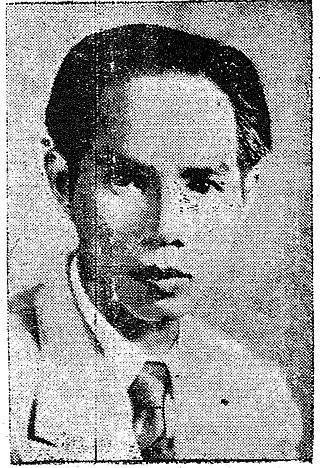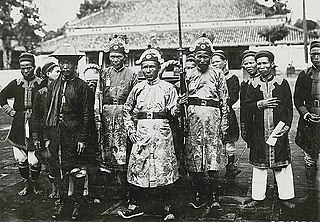Related Research Articles

French Indochina, officially known as the Indochinese Union and after 1941 as the Indochinese Federation, was a group of French dependent territories in Southeast Asia from 1887 to 1954. It was initially a federation of French colonies (1887–1949), later a confederation of associated states within the French Union (1949-54). It comprised Cambodia, Laos, Guangzhouwan (1898–1945), Cochinchina, and Vietnamese regions of Tonkin and Annam. It was established in 1887 and was dissolved in 1954. In 1949, Vietnam was reunited and it regained Cochinchina. Its capitals were Hanoi (1902–45) and Saigon.

Annam, or Trung Kỳ (中圻), was a French protectorate encompassing what is now Central Vietnam from 1883 to 1949. Like the French protectorate of Tonkin, it was nominally ruled by the Vietnamese Nguyễn dynasty. Before the protectorate's establishment, the name Annam was used in the West to refer to Vietnam as a whole; Vietnamese people were referred to as Annamites. The protectorate of Annam became a part of French Indochina in 1887. The region had a dual system of French and Vietnamese administration. The government of the Nguyễn Dynasty still nominally ruled Annam and Tonkin as the Empire of Đại Nam, with the emperor residing in Huế. On 27 May 1948, the protectorate was partly merged in the Provisional Central Government of Vietnam, which was replaced the next year by the newly established State of Vietnam. The French legally maintained the protectorate until they formally signed over sovereignty to the Bảo Đại and the government of the State of Vietnam in 1950 after signing the Élysée Accords in 1949. The region was divided between communist North Vietnam and anti-communist South Vietnam under the terms of the Geneva Accord of 1954.

The Nguyễn dynasty was the last Vietnamese dynasty, preceded by the Nguyễn lords and ruling unified Vietnam independently from 1802 until French protectorate in 1883. Its emperors were members of the House of Nguyễn Phúc. During its existence, the Nguyễn empire expanded into modern-day Southern Vietnam, Cambodia, and Laos through a continuation of the centuries-long Nam tiến and Siamese–Vietnamese wars. With the French conquest of Vietnam, the Nguyễn dynasty was forced to give up sovereignty over parts of Southern Vietnam to France in 1862 and 1874, and after 1883 the Nguyễn dynasty only nominally ruled the French protectorates of Annam as well as Tonkin. Backed by Imperial Japan, in 1945 the last Nguyễn emperor Bảo Đại abolished treaties with France and proclaimed the Empire of Vietnam for a short time until 25 August 1945.

Cochinchina or Cochin-China is a historical exonym for part of Vietnam, depending on the contexts, usually for Southern Vietnam. Sometimes it referred to the whole of Vietnam, but it was commonly used to refer to the region south of the Gianh River.

Tạ Thu Thâu (1906–1945) in the 1930s was the principal representative of Trotskyism in Vietnam and, in colonial Cochinchina, of left opposition to the Indochinese Communist Party (PCI) of Nguyen Ai Quoc. He joined to Left Opposition to the United Front policy of the Commintern as a student in Paris in the late 1920s. After a period of uneasy co-operation with "Stalinists" on the Saigon paper La Lutte, he triumphed over the Communists in the 1939 elections to the Cochinchina Colonial Council on a platform that called for radical land reform and workers' control, and opposed defense collaboration with the French authorities. He was executed by the Communist Viet Minh in September 1945.

The Catholic Church in Vietnam is part of the worldwide Catholic Church, under the spiritual leadership of bishops in Vietnam who are in communion with the Pope in Rome. Vietnam has the fifth largest Catholic population in Asia, after the Philippines, India, China and Indonesia. There are about 7 million Catholics in Vietnam, representing 7.4% of the total population. There are 27 dioceses with 2,228 parishes and 2,668 priests. The main liturgical rites employed in Vietnam are those of the Latin Church.

French Cochinchina was a colony of French Indochina from 1862 to 1949, encompassing what is now Southern Vietnam. The French operated a plantation economy whose primary strategic product was rubber.

The Empire of Vietnam was a short-lived puppet state of Imperial Japan between March 11 and August 25, 1945. It was a member of the Greater East Asia Co-Prosperity Sphere. It was ruled by the Nguyễn dynasty and created when Emperor Bảo Đại declared independence for Vietnam from French protection. At the end of its existence, on 14 August 1945, the empire also successfully reclaimed Cochinchina as part of Vietnam.

Trotskyism in Vietnam was represented by those who, in left opposition to the Indochinese Communist Party (ICP) of Hồ Chí Minh, identified with the call of Leon Trotsky to re-found "vanguard parties of proletariat" on principles of "proletarian internationalism" and of "permanent revolution". Active in the 1930s in organising the Saigon waterfront, industry and transport, Trotskyists presented a significant challenge to the Moscow-aligned party in Cochinchina. Following the September 1945 Saigon uprising against the restoration of French colonial rule, Vietnamese Trotskyists were systematically hunted down and eliminated by both the French Sûreté and the Communist-front Viet Minh.

At the onset of World War I, Vietnam, nominally under the Nguyễn dynasty, was under French protectorate and part of French Indochina. While seeking to maximize the use of Indochina's natural resources and manpower to fight the war, France cracked down all Vietnamese patriotic movements. Many Vietnamese fought later in the conflict.
Anarchism in Vietnam first emerged in the early 20th century, as the Vietnamese started to fight against the French colonial government along with the puppet feudal dynasty for either independence or higher autonomy. Some famous radical figures such as Phan Bội Châu and Nguyễn An Ninh became exposed to strands of anarchism in Japan, China, and France. Anarchism reached its apex in Vietnam during the 1920s, but it soon began to lose its influence with the introduction of Marxism-Leninism and the beginning of the Vietnamese communist movement. In recent years, Anarchism in Vietnam has attracted new adherents.
The Bombardment of Tourane was a naval incident that took place during the short reign of the Vietnamese emperor Thiệu Trị (1841–47), which saw a considerable worsening of relations between France and Vietnam. The French warships Gloire and Victorieuse, which had been sent to Tourane to negotiate for the release of two French Catholic missionaries, were surprise attacked by several Vietnamese vessels. The two French ships fought back, sinking four Vietnamese corvettes, badly damaging a fifth, and inflicting just under 230 casualties. In response to this and other provocations, the French eventually decided to intervene actively in Vietnam, and a decade later launched the Cochinchina Campaign (1858–62), which inaugurated the period of French colonial rule in Vietnam.

The Cochinchina campaign was a series of military operations between 1858 and 1862, launched by a joint naval expedition force on behalf of the French Empire and the Kingdom of Spain against the Nguyễn period Vietnamese state. It was the opening conflict of the French conquest of Vietnam.

La Lutte was a left-wing paper published in Saigon, French-colonial Cochinchina, in the 1930s. It was launched ahead of the April–May 1933 Saigon municipal council election as a joint organ of the Indochinese Communist Party (PCI) and a grouping of Trotskyists and others who agreed to run a joint "Workers' slate" of candidates for the polls. This kind of cooperation between Trotskyists and Comintern-linked communists was a phenomenon unique to Vietnam. The editorial line of La Lutte avoided criticism of the USSR while supporting the demands of workers and peasants without regard to faction. The supporters of La Lutte were known as lutteurs.
The Vietnamese Revolutionary Youth League, or Thanh Niên for short, was founded by Nguyen Ai Quoc in Guangzhou in the spring of 1925. It is considered as the “first truly Marxist organization in Indochina” and “the beginning of Vietnamese Communism”. With the support of the Chinese Communist Party and the Kuomintang left, from 1925 to 1927, the League managed to educate and train a considerable number of Marxist-Leninist revolutionaries, preparing the prominent leadership for the Communist Party of Vietnam and the Vietnamese Revolution. At the time, Vietnam was part of colonial French Indochina.

Phan Văn Hùm was a Vietnamese journalist, philosopher and revolutionary in French colonial Cochinchina who, from 1930, participated in the Trotskyist left opposition to the Communist Party of Nguyen Ai Quoc.
Colonial Council elections were held in French Cochinchina on 16 April 1939.

Tonkin, or Bắc Kỳ, was a French protectorate encompassing modern Northern Vietnam from 1883 to 1949. Like the French protectorate of Annam, Tonkin was still nominally ruled by the Vietnamese Nguyễn dynasty. In 1886, the French separated Tonkin from the Nguyễn imperial court in Huế by establishing the office of "Viceroy". However, on 26 July 1897, the position of Viceroy was abolished, officially making the French resident-superior of Tonkin both the representative of the French colonial administration and the Nguyễn dynasty court in Huế, giving him the power to appoint local mandarins. In 1887, Tonkin became a part of the Union of Indochina.

The Military of the Nguyễn dynasty were the main military forces of the Nguyễn dynasty from 1802 to August 1945 when it was dismantled by the August Revolution. The Nguyễn military force was initially formed by Nguyễn Hoàng as a division of the military of the Revival Lê dynasty in 1558 starting out with 3000 soldiers. During this period it was the military forces of the domain of the Nguyễn lords and commonly fought the Trịnh lords who controlled northern Vietnam. During the Tây Sơn Rebellion it was expelled out most of the county by the Tây Sơn dynasty. After the exiled Nguyễn Phúc Ánh returned and defeated the Tây Sơn rebels he crowned himself as the Gia Long Emperor and the Nguyễn military became the national military of Vietnam.

The French conquest of Vietnam1 (1858–1885) was a series of military expeditions that pitted the Second French Empire, later the French Third Republic, against the Vietnamese empire of Đại Nam in the mid-late 19th century. Its end results were victories for the French as they defeated the Vietnamese and their Chinese allies in 1885, the incorporation of Vietnam, Laos, and Cambodia, and finally established French rules over constituent territories of French Indochina over Mainland Southeast Asia in 1887.
References
- ↑ Justin Corfield (2014) Historical Dictionary of Ho Chi Minh City, Anthem Press, pxxi
- ↑ Paul H. Kratoska (2001) South East Asia, Colonial History: High imperialism (1890s-1930s), Taylor & Francis, p311
- ↑ Robert Jackson Alexander (1991) International Trotskyism, 1929-1985: A Documented Analysis of the Movement, Duke University Press, 1 Jan 1991, p962
- ↑ K W Taylor (2013) A History of the Vietnamese, Cambridge University Press, p515